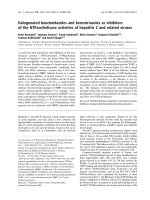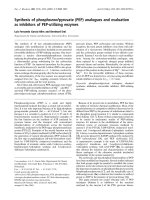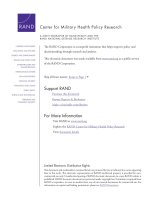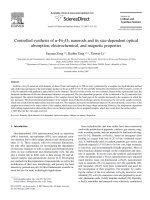Design and synthesis of cysmethynil and analogues as inhibitors of isoprenylcysteine carboxyl methyltransferase (ICMT)
Bạn đang xem bản rút gọn của tài liệu. Xem và tải ngay bản đầy đủ của tài liệu tại đây (1.36 MB, 220 trang )
DESIGN AND SYNTHESIS OF CYSMETHYNIL
ANALOGUES AS INHIBITORS OF ISOPRENYLCYSTEINE
CARBOXYL METHYLTRANSFERASE (ICMT)
LEOW
JO LENE
(B.Sc.(Pharmacy)(Hons.), NUS)
A THESIS SUBMITTED FOR
THE DEGREE OF DOCTOR OF PHILOSOPHY IN SCIENCE
(MEDICINAL CHEMISTRY)
DEPARTMENT OF PHARMACY
NATIONAL UNIVERSITY OF SINGAPORE
2009
ii
ACKNOWLEDGEMENT
First and foremost, I would like to express my heartfelt gratitude to my
supervisor, A/Prof Go Mei Lin, for her constant guidance and advice throughout the
course of my research and writing of this thesis, without which this work would not
be possible. Her continuous encouragements, support and patience are also deeply
appreciated.
My sincere thanks also goes to my co-supervisor, Prof Patrick J. Casey, of
Duke-NUS Graduate Medical School, for his continuous guidance, encouragements
and immense knowledge, and the opportunity to work along side experienced research
fellows in the Casey lab at Duke University Medical Center, Durham, NC.
I would also like to thank Dr Mei Wang for her support, advice and
motivations and the opportunity to carry out my research work at the Casey lab at
Duke-NUS Graduate Medical School.
It is also my pleasure to thank the following research fellows who made this
thesis possible: Dr Rudi Baron, for his assistance in performing the biological assay
on the initial chemical library; Dr Suresh Kumar Gorla, for his assistance in
completing my chemical library and his advice in my synthetic chemistry work; Dr
Yuri Karl Peterson, for preparing the enzymes necessary for my work and his
guidance in my biological work; and Dr Andreas Peter Schüller, for sharing his
immense knowledge and assistance in my computational work.
I am also indebted to the all the laboratory managers, technologists and
assistants, for their invaluable technical assistance, and providing me with the
necessary reagents and equipments. Special thanks to Mdm Oh Tang Booy, Ms Ng
Sek Eng, Ms Tee Hui Wearn, Ms Audrey Chan, from the Department of Pharmacy,
NUS; Mr Lee Peng Chou, Mr Heng Joo Seng, Ms Ho Pei Leng, Ms Kavitha
iii
Ramalingan, Mr Seah Hao from the Research Operation department, Duke-NUS
GMS.
I am also grateful to my fellow postgraduates and labmates: Dr Liu Xiaoling,
Dr Zhang Wei, Mr Lee Chong Yew, Ms Sim Hong May, Ms Nguyen Thi Hanh Thuy,
Mr Wee Xi Kai, Mr Yeo Wee Kiang and Mr Pondy Murgappan Ramanujulu, from
A/Prof Go’s lab in the Department of Pharmacy, NUS; Dr Zhou Jin, Dr Liu Sen, Ms
Tan Wan Loo and Ms Tan Yen Ling, Jessie, from the Casey lab of Duke-NUS GMS;
and all the labmates from the Casey lab in Duke University Medical Center, Durham,
NC.
Last but not least, I owe my deepest gratitude to my family who had given me
their tremendous support, without them, I would not be here.
iv
CONFERENCES AND PUBLICATIONS
Conference presentation
1. 3
rd
Pharmaceutical Sciences World Congress, Amsterdam, The Netherlands
(22-25 April 2007): Optimising drug Therapy: An Imperative for World
Health. Poster presentation titled “Quantitative Structure-Activity Relationship
(QSAR) of indoloacetamides as inhibitors of human isoprenylcysteine
carboxyl methyltransferase”.
2. Experimental Biology 2009, New Orleans, Louisiana (18 – 22 April 2009):
Today’s Research: Tomorrow’s Health. Poster presentation titled “Analogues
of cysmethynil demonstrate improved isoprenylcysteine carboxyl
methyltransferase (Icmt) inhibition activity and antiproliferative activity in
PC3 prostate cancer and MDA-MB-231 breast cancer cells”.
Publications
1. Leow JL, Baron R, Casey PJ, Go ML. Quantitative structure-activity
relationship (QSAR) of indoloacetamides as inhibitors of human
isoprenylcysteine carboxyl methyltransferase. Bioorg Med Chem Lett. 2007,
17, 1025-32.
2. Wang M, Tan W, Zhou J, Leow J, Go M, Lee HS, Casey PJ. A small molecule
inhibitor of isoprenylcysteine carboxymethyltransferase induces autophagic
cell death in PC3 prostate cancer cells. J Biol Chem. 2008, 283, 18678-84.
v
Manuscripts in preparation
1. Leow JL, Gorla SK, Go ML, Wang M, Casey PJ. Analogues of the
Isoprenylcysteine Carboxylmethyltransferase Inhibitor Cysmethynil With
Improved Antiproliferative Activity Against Breast and Prostate Cancer Cells
2. Go ML, Leow JL, Gorla SK, Schüller AP, Wang M, Casey PJ. Amino
derivatives of indole as potent inhibitors of isoprenylcysteine carboxyl
methyltransferase (Icmt).
vi
TABLE OF CONTENTS
ACKNOWLEDGEMENT ii
CONFERENCES AND PUBLICATIONS iv
TABLE OF CONTENTS vi
SUMMARY x
LIST OF TABLES xiv
LIST OF FIGURES xv
LIST OF SCHEMES xvii
LIST OF ABBREVIATIONS xviii
CHAPTER 1 INTRODUCTION 1
1.1. Overview of post-translational prenylation of proteins 1
1.2. CaaX processing enzymes as targets in oncogenesis 5
1.2.1. Inhibitors of FTase 5
1.2.2. GGTase-I inhibitors 6
1.2.3 Inhibitors of the post-prenylation enzymes: Rce1 and Icmt 6
1.2.3.1. Rce1 inhibitors 7
1.2.3.2. Icmt inhibitors 9
1.3 Statement of Purpose 12
CHAPTER 2: QUANTITATIVE STRUCTURE ACTIVITY
RELATIONSHIP (QSAR) OF INDOLOACETAMIDES AS
INHIBITORS OF ICMT 16
2.1. Introduction 16
2.2. Methods 16
2.3. Results and Discussion 18
2.3.1. The indole database 18
2.3.2. Analysis by Projection Methods PCA and PLS 21
2.3.3. Analysis by Multiple Linear Regression 26
2.3.4. Comparative Molecular Field Analysis (CoMFA) 29
2.4. Conclusions 34
vii
CHAPTER 3: DESIGN AND SYNTHESIS OF CYSMETHYNIL
ANALOGUES 36
3.1. Introduction 36
3.2. Rationale of Design 36
3.2.1. Drug-like character of synthesized compounds 36
3.2.2. Modifications at position 5 38
3.2.3. Modifications at position 1 39
3.2.4. Modification of the acetamide side chain at position 3 40
3.2.5. Classification of target compounds 44
3.3 Chemical Considerations 48
3.3.1 Series 1 and 2 48
3.3.2. Series 3 51
3.3.3. Series 4 52
3.3.4. Series 5 53
3.3.5. Series 6 56
3.4. Experimental 57
3.4.1. General Details 57
3.4.2. Synthesis of Series 1 and 2 compounds 58
3.4.3. Synthesis of Series 3 compounds 63
3.4.4. Synthesis of Series 4 compounds (4-1 and 4-3) 67
3.4.5. Synthesis of Series 5 compounds 69
3.4.6. Synthesis of compounds in Series 6 (6-11, 6-12) 76
3.5. Summary 77
CHAPTER 4: INVESTIGATIONS INTO THE ICMT INHIBITORY
AND ANTIPROLIFERATIVE ACTIVITIES OF SYNTHESIZED
COMPOUNDS 78
4.1. Introduction 78
4.2. Experimental Methods 78
4.2.1. Materials for biological assay 78
4.2.2. Outline of the Icmt inhibition assay 79
4.2.3. Measurement of Icmt activity 80
4.2.4. Outline of the cell viability assay 80
4.2.5. Cell Viability Assay 81
4.3. Results 82
4.3.1. Effect of structural modifcations on Icmt inhibitory activity: Position 5 86
4.3.2. Effect of structural modifcations on Icmt inhibitory activity: Position 1 86
4.3.3. Effect of structural modifcations on Icmt inhibitory activity: Acetamide side
chain at position 3 87
4.3.4. Effect of structural modifcations on Icmt inhibitory activity: Series 6
compounds 89
viii
4.3.5. Effect on cell growth/proliferation 91
4.3.6. Hill slopes of dose response curves for determination of IC
50
values 92
4.3.7. SAR for antiproliferative activity 95
4.4. Discussion 97
4.5. Conclusion 100
CHAPTER 5: PHARMACOPHORE MODELING AND QSAR 102
5.1. Introduction 102
5.2 Materials and Methods 103
5.2.1. General 103
5.2.2. Generation of the Pharmacophore Model 105
5.2.3. Multiple linear regression (MLR) and Spearman correlation analysis 107
5.2.4. PLS Analysis 107
5.2.5. CoMFA Analysis 107
5.3. Results and discussion 108
5.3.1. Establishing a pharmacophore model for Icmt inhibition 108
5.3.2. Multiple linear regression and correlation analysis 115
5.3.3. PLS regression analysis 119
5.3.4. 3D QSAR 122
5.4. Conclusion 129
CHAPTER 6: INVESTIGATIONS INTO THE EFFECT OF
SELECTED DERIVATIVES OF CYSMETHYNIL ON VIABILITY
OF CANCER CELL LINES 131
6.1. Introduction 131
6.2 Materials and methods 132
6.2.1. Materials 132
6.2.2. Cell Viability Assay 133
6.2.3. Cell cycle analysis 133
6.2.4. Western blot analysis 134
6.3 Results 135
6.3.1. Effect of 4-3 and 6-4 on viability of human prostate (PC3) and breast
(MDA-MB-231) cancer cells 135
6.3.2. Effects of 4-3 and 6-4 on cell cycle of MDA-MB-231 and PC3 cells 139
6.3.3. Effects of 4-3 and 6-4 on autophagic-induced cell death 141
6.4. Discussion 144
6.5. Conclusion 146
ix
CHAPTER 7 CONCLUSION AND FUTURE WORK 147
BIBLIOGRAPHY 151
APPENDICES……………………………………………………… 160
Appendix 1. QSAR of indoloacetamides 160
Appendix 2. Synthesis and Characterization of Cysmethynil
Analogues by Dr Suresh Kumar Gorla 163
A2.1. Synthesis of 1-8 (Series 1) 163
A2.2. Synthesis of 3-2 and 3-7 (Series 3) 164
A2.3. Synthesis of Series 4 compounds (4-2, 4-4 to 4-10) 165
A2.4. Synthesis of the 5-1 and 5-6 (Series 5) 169
A2.5. Synthesis of the 6-1 to 6-10 (Series 6) 171
Appendix 3. HPLC Purity Determination of All Synthesized
Compounds 178
Appendix 4. QSAR of Synthesized Analogues 180
x
SUMMARY
The objective of this thesis was to investigate the chemotherapeutic potential
of a group of compounds with an indole core structure as isoprenylcysteine carboxyl
methyltransferase (Icmt) inhibitors. Ras proteins contain a C-terminal CaaX motif
which direct the proteins through a three-step post-translational process termed
prenylation, in which Icmt catalyzes the last step methylation of the C-terminal
prenylcysteine. Inhibition of Icmt has multiple impacts on cellular signaling processes
which ultimately leads to cell death.
The lead Icmt inhibitor, cysmethynil, was identified from a screen of a diverse
chemical library of ~10,000 compounds. A structure activity relationship (SAR) study
was first carried out on the indole core compounds discovered from the library.
Different methods were employed in this study, namely the (i) principal component
anaylsis (PCA) and partial least squares projection to latent structures (PLS), (ii)
multiple linear regression and (iii) comparative molecular field analysis (CoMFA).
All three approaches complement each other, and identified the steric factor to be
important for activity. Improved activity was predicted by incorporation of a bulky
side chain at position 1 of the indole ring while a smaller substituent at the position 5
phenyl ring was preferred for Icmt inhibition activity.
Lead optimization efforts guided by the SAR results were performed together
with conventional analogue design approach. The compounds synthesized were
classified according to (i) substitution on position 1 (Series 1), (ii) alteration at
position 5 (Series 2), and (iii) modification of the acetamide side chain at position 3
(Series 3: tertiary amides, Series 4: amines and Series 5: homologues and
bioisosteres). A 6
th
series consisted of compounds with modification made at more
than one position (1, 3 and/or 5). The synthesized compounds were evaluated for Icmt
xi
inhibition activity and effects on the viability of human breast cancer cells. Based
Icmt inhibitory activity, it was found that the position 3 subsituent was important for
activity, as demonstrated by the complete loss of activity in compounds lacking a
substituent at this position. Further evaluation of other variation at this position
elucidated the importance of a H bond acceptor property at position 3. Optimal length
and flexibility is also necessary for activity, as seen in the loss of activity for the
shortened homologue. Although presence of substituents at position 1 and 5 was also
important for activity, omission of either substituent only resulted in a drop in activity
rather than a complete loss of activity. The need for a bulky substituent at position 5
as discovered in the previous QSAR study was verified, as seen by the drop in activity
when a shorter side chain such as the 5-carbon isoprenyl moiety was incorporated.
Good correlation was observed between the Icmt inhibition and
antiproliferative activities. The SAR of the antiproliferative activity observed was the
same as that of the Icmt inhibitory activity, with the exception that the amine
analogues (Series 4) were significantly more potent than the other series.
Computational methods were employed to analyze the results from the
biological evaluation, specifically the Icmt inhibitory activity, on the 47 compounds
synthesized. A pharmacophore model was first developed from the Icmt inhibition
data, identifying aromatic and hydrophobic groups as the main features of the indole
based Icmt inhibitors, and a H bond acceptor group as the only polar feature in the
model. Other reported Icmt inhibitors were screened against the model and 5 out of
the 14 screened were found to comply. Further validation could be carried out by
actual determination of the biological activity of prospective library screen hits.
QSAR analysis was also carried out on the same set of biological data using multiple
linear regression, MOE’s AutoQsar and Sybyl’s CoMFA/CoMSIA. The models
xii
complement each other and also agreed with the pharmacophore model, where size
and hydrophobicity was determined to be the main contributor to activity.
Visualization of the steric field from CoMFA identified that substituent at position 1
and 5 provides the bulk important for activity.
To better understand the consequences of Icmt inhibition, the amino analogues
identified as the most potent inhibitors thus far, were selected for further detailed
biological evaluation. Prior studies have demonstrated that inhibition of Icmt by
cysmethynil has resulted in various downstream effects such as cell cycle arrest and
induction of autophagy, resulting in cell death. Investigation of these biological
consequences were conducted on the selected amine analogues and they were found
to be able to demonstrate the same effects, with some analogues showing activity
more prominently and at much lower doses.
In conclusion, the indole analogues are effective as Icmt inhibitors and are
potentially useful as chemotherapeutic agents. The lead optimization effort has
elucidated the amine analogues as Icmt inhibitors with significantly improved activity
in cell-based studies. These compounds may be used for further investigation of the
outcome of Icmt inhibition and subsequent pre-clinical studies. However, there are
some limitations in these compounds due to their high lipophilic nature (ClogP > 5).
Issues may arise in pre-clinical studies due to difficulties in formulating the
compound into a dosage form that can be administered into the test animals. One
possible approach to circumvent this problem is to identify new leads with different
scaffolds that maybe less lipophilic and more drug-like. The pharmacophore model
generated using the synthesized library of compounds may be useful in this aspect,
where it can be used to screen against database of lead-like or drug-like compounds
xiii
that can be readily obtained for biological evaluation. A new lead compound may also
assist in our quest to further understand the consequences of Icmt inhibition.
xiv
LIST OF TABLES
Table 2-1. Structures and experimental
a
pIC
50
values of compounds in database. 18
Table 2-2. Pearson Correlation Coefficients of Parameters employed in developing
Equation (2-1) 28
Table 2-3. Summary of CoMFA Analysis of Training Set (n = 56) 32
Table 3-1. ClogP
a
of secondary and tertiary amide analogues of cysmethynil
b
42
Table 3-2. Structures and ClogP values of Series 1 compounds. 44
Table 3-3. Structures and ClogP values of Series 2 compounds. 45
Table 3-4. Structures and ClogP values of Series 3 compounds. 45
Table 3-5. Structures and ClogP values of Series 4 compounds. 46
Table 3-6. Structures and ClogP values of Series 5 compounds. 46
Table 3-7. Structures and ClogP values of Series 6 compounds. 47
Table 4-1. IC
50
values for Icmt inhibition and antiproliferative activities of test
compounds. 83
Table 5-1. Descriptors used for MLR and PLS Regression Analyses
a
104
Table 5-2. Hydrogen-bond donating and accepting features in representative side
chains at position 3 of the indole scaffold. 110
Table 5-3. CoMFA and selected CoMSIA models 123
Table 6-1. Structures, IC50 values, ClogP and SlogP values of cysmethynil (1-1), 4-3,
6-4 and 6-5. 132
xv
LIST OF FIGURES
Figure 1-1. Post-translational modification of CaaX proteins 2
Figure 1-2. Structures of selected FTIs 5
Figure 1-3. Structures of small molecule GGTIs 6
Figure 1-4. Structures of selected Rce1 inhibitors 8
Figure 1-5. Inhibition of Icmt by SAH and compounds that increase intracellular
SAH 10
Figure 1-6. Structures of (a) minimal substrate of Icmt and (b) substrate based
inhibitors 10
Figure 1-7. Structures of reported natural product inhibitors. 11
Figure 1-8. Structure of Cysmethynil with numbering system used in this thesis. 12
Figure 2-1. Loading plot of first and second principal components (p[1], p[2]) of 72
compounds and 20 descriptors 23
Figure 2-2. Score plot of principal components t1 versus t2 for compounds (n = 72, 20
descriptors) 124
Figure 2-3. Coefficient plot for PLS model derived from 70 compounds and 14
descriptors, based on the first component 126
Figure 2-4. Alignment of the 72 compounds 30
Figure 2-5. Steric map from the CoMFA model showing the alignment based on
indole ring as shown in Figure 2-4. 33
Figure 2-6. Electrostatic map from the CoMFA model showing the same alignment as
in Figure 2-4 34
Figure 3-1. Evaluation of drug-like character of cysmethynil 38
Figure 3-2. Length of side chains at position 1 in cysmethynil and its m-
trifluromethylbenzyl, isoprenyl and geranyl analogues 40
Figure 3-3. Restricted flexibility of the C-3 side chain in the shortened homologue of
cysmethynil 41
Figure 3-4. Amino analogues of cysmethynil targeted for synthesis (side chain at
position 3) 42
Figure 3-5. Isosteric replacement of the acetamide side chain of cysmethynil. 43
Figure 3-6. Reaction mechanisms involved in the formation of the nitrile 1. 49
xvi
Figure 3-7. Reaction mechanisms involved in the hydrolysis of nitrile 1 to give the
amide 2 49
Figure 3-8. Mechanism of Suzuki Coupling.
76
50
Figure 3-9. Mechanism of transmetallation.
76
51
Figure 3-10. Mechanism of N-alkylation of 2-(5-substituted phenyl-1H-indol-3-yl)
acetamides 51
Figure 3-11. Mechanism of the Mannich reaction 53
Figure 4-1. Series 6 compounds with isoprenyl side chain at position 1 90
Figure 4-2. Inhibition of Icmt by cysmethynil and analogues 93
Figure 4-3. Antiproliferative activity of cysmethynil and analogues. 93
Figure 5-1. Pharmacophore model 113
Figure 5-2. Known Icmt inhibitors with pharmacophoric features that match the
proposed model 114
Figure 5-3. Alignment of compounds based on pharmacophore model 123
Figure 5-4. CoMFA steric contour map 125
Figure 5-5. CoMFA electrostatic contour map 126
Figure 5-6. Hydrogen bond donor/acceptor contour map 128
Figure 5-7. CoMSIA hydrophobic contour map 129
Figure 6-1. Effect of cysmethynil, 3-1, 4-3 and 6-4 on cell viability (72 h) of (A)
MDA-MB-231 cells and (B) PC3 cells 135
Figure 6-2. Effect of (A) cysmethynil, (B) 4-3, (C) 6-4 on viability of MDA-MB-231
cells over 3 days 137
Figure 6-3. Effect of (A) cysmethynil, (B) 4-3, (C) 6-4 on viability of PC3 cells over
time 3 days. 139
Figure 6-4. DNA content analysis of MDA-MB-231 breast cancer cells, after 24 h
incubation with (i) vehicle, (ii) cysmethynil; (iii) 4-3; (iv) 6-4 and (v) 3-1. 141
Figure 6-5. DNA content analysis of PC3 prostate cancer cells after 24 h incubation
with (i) vehicle, (ii) cysmethynil; (iii) 4-3; (iv) 6-4 and (v) 3-1 141
Figure 6-6. Effect of cysmethynil, 4-3, 6-4 and 3-1 on LC3-1 and LC3-II protein
levels in MDA-MB-231 breast cancer cell lysates. 143
Figure 6-7. Effect of cysmethynil, 4-3, 6-4 and 3-1 on LC3-1 and LC3-II protein
levels in PC3 prostate cancer cell lysates 144
xvii
LIST OF SCHEMES
Scheme 3-1. Synthesis of Series 1 and 2 compounds 48
Scheme 3-2. Synthesis of Series 3 compounds 52
Scheme 3-3. Synthesis of Series 4 compounds 52
Scheme 3-4. Synthesis of compounds 5-1, 5-5 and 5-6 54
Scheme 3-5. Synthesis of compound 5-2 55
Scheme 3-6. Synthesis of compounds 5-3 and 5-4 56
xviii
LIST OF ABBREVIATIONS
13
C NMR
Carbon-13 nuclear magnetic resonance spectrum
1
H NMR
Proton nuclear magnetic resonance spectrum
3D-QSAR
Three dimensional quantitative structure activity relationship
AdoHcy
S-adenosylhomocysteine (also SAH)
AdoMet
S-adenosylmethionine (also SAM)
APCI
Atmospheric pressure chemical ionization
BFC
Biotin-S-farnesylcysteine
CD
3
OD
Deuterated methanol
CDCl
3
Deuterated chloroform
CDK
Cyclin-dependent kinase
ClogP
Calculated log octanol/water partition coefficient
CoMFA
Comparative molecular field analysis
CoMSIA
Comparative molecular similarity indices analysis
DMEM
Dulbecco's Modified Eagle's Medium
DME
Dimethoxyethane
DMF
N,N-Dimethylformamide
DMSO-d
6
Deuterated dimethylsulfoxide
EDTA
Ethylenediaminetetraacetic acid
ESI
Electron spray ionization
FACS
Fluorescence activated cell sorter analysis
FBS
Fetal bovine serum
FN
False negative
FP
False positive
FTase
Farmesyltransferase
GAP
GTPase activating protein
xix
GAPDH
Glyceraldehyde-3-phosphate dehydrogenase
GDP
Guanosine 5'-diphosphate
GEF
Guanosine nucleotide exchange factor
GGTase-I
Geranylgeranyltransferase type I
GTP
Guanosine 5'-triphosphate
Hepes
4-(2-hydroxyethyl)-1-piperazineethanesulfonic acid
HOMO
Highest occupied molecular orbital
HPLC
High performance liquid chromatography
HRMS
High resolution mass spectrum
Icmt
Isoprenylcysteine carboxyl methyltransferase
K
d
Dissociation constant
LC3
Microtubule-associated protein 1 light chain 3 (also MAP1LC3)
LUMO
Lowest unoccupied molecular orbital
MDA-MB-231
Human breast cancer cell line
MLR
Multiple linear regression
MOE
Molecular Operating Environment
mTOR
Mammalian target of rapamycin
MTS
3-(4,5-Dimethylthiazol-2-yl)-5-(3-carboxymethyoxyphenyl)-2-
(4-sulfonphenyl)-2H-tetrazolium
PBS
Phosphate-buffered saline
PC3
Human prostate cancer cell line
PCA
Principal component analysis
PLS
Partial least squares projection to latent structures
PVDF
Polyvinylidene difluoride
Rce1
Ras converting enzyme
RIPA
Radioimmunoprecipitation assay
SAH
See AdoHcy
xx
SAM
See AdoMet
SDS-PAGE
Sodium dodecyl sulfate polyacrylamide gel electrophoresis
SEE
Standard error of estimate
SEP
Standard error of prediction
THF
Tetrahydrofuran
TMS
Tetramethylsilane
TN
True negative
TP
True positive
CHAPTER 1
1
CHAPTER 1 INTRODUCTION
1.1. OVERVIEW OF POST-TRANSLATIONAL PRENYLATION OF
PROTEINS
Many proteins are subjected to a range of chemical modifications after they
are synthesized. These modifications are termed post-translation modifications and
may involve the attachment of other functional groups (by acylation, phosphorylation,
glycosylation, glycation, prenylation among others) or peptides (eg. ubiquitination) to
the original protein, a change in the chemical nature of a specific amino acid (for
example deamination of arginine to give citrulline) or changes in structure like the
formation of disulfide bridges between cysteine residues. These modifications can
have a significant impact on the biological activity of the protein. Over the past
decade, post-translational modification of proteins by isoprenoid lipids, a process
termed prenylation, has been widely investigated due in part to its central role in the
subcellular localization and function of a group of proteins characterized by a
carboxy-terminal tetrapeptide (CaaX) motif, where “C” is cysteine, “a” is an aliphatic
amino acid and “X” represents an unspecified amino acid.
1-2
The presence of this
motif on a protein triggers three sequential post-translational modifications which are
depicted in Figure 1-1.
CHAPTER 1
2
FTase or
GGTase
O
aaX
SH
O
aaX
S
R
O
O
-
S
R
O
O
S
R
Me
RPP
PPi
aaX
Rce1
Icmt
where R =
O
O
S
Me
plasma membrane
ER membrane
transport to
plasma
membrane
SAM
SAH
Figure 1-1. Post-translational modification of CaaX proteins.
2-3
In the first step of CaaX protein processing, an isoprenoid residue, farnesyl
(15-carbon) or geranylgeranyl (20-carbon), is attached by a thioether linkage to the
cysteine of the CaaX sequence.
3
This reaction is catalyzed by protein
farnesyltransferase (FTase) or protein geranylgeranyltransferase type I (GGTase-I).
Generally, when X is methionine, serine, glutamine or alanine, the protein is a
substrate of FTase, whereas if X is leucine, it is processed by GGTase-I.
2, 4
The nature
of the X residue does provide some guidance as to whether the CaaX sequence is
farnesylated or geranylgeranylated but it is still best to rely on experimental
confirmation.
5
There are some CaaX proteins that are substrates of both FTase and
GGTase-I, for example, K-Ras, RhoB and RhoH.
4
After prenylation, the modified
CaaX protein moves from the cytosol to the endoplasmic reticulum where it
CHAPTER 1
3
associates with the cellular membrane presumably by inserting its lipophilic
isoprenoid side chain into the phospholipid bilayer. It is then recognized by an
endoprotease termed Ras converting enzyme 1 (Rce1), an integral ER membrane
protein, that removes the last three amino acids (-aaX) from the C-terminus.
6
This
brings the newly exposed -carboxylate anion of the prenylcysteine residue in close
proximity to the negatively charged phospholipids in the membrane. Likely due in
part to minimize the electrostatic repulsion, the terminal carboxylate group is
converted to a methyl ester in a reaction catalyzed by isoprenylcysteine carboxyl
methyltransferase (Icmt), which like Rce1 is a membrane bound protein located in the
endoplasmic reticulum.
7-8
Unlike the preceding steps, methylation by Icmt is
potentially reversible
9
but a specific methylesterase catalyzing this step has yet to be
identified. The sequence of reactions involved in the post-translational prenylation of
CaaX proteins enhances the lipophilic character of otherwise hydrophilic proteins and
promotes their ability to associate with membranes and to engage in specific protein-
protein interactions.
3
About 280 potential CaaX proteins were identified during the sequencing of
the human and mouse genomes but less than half of these proteins were proposed to
undergo post-translational prenylation.
10
It appears that the processing enzymes do
not recognize a particular CaaX sequence or fail to gain access to certain terminal
carboxyl groups.
11
An important class of CaaX proteins that are processed by
prenylation are the Ras proteins, which play essential roles in controlling several
crucial signaling pathways that regulate normal cellular proliferation. Ras proteins
function as binary molecular switches that alternate between two states, an inactive
state in which Ras is in complex with guanosine 5’-diphosphate (GDP) and an
activated state in which it is bound to guanosine 5’-triphosphate (GTP).
12
The
CHAPTER 1
4
equilibrium between these states is regulated by two proteins: guanine nucleotide
exchange factors (GEFs) which promote activation by enhancing the release of GDP
and the binding of GTP, and GTPase activating proteins (GAPs) which promote
inactivation by accelerating the intrinsic GTPase activity of the Ras proteins.
13
In the
activated state, Ras proteins trigger an array of cellular messengers that transduce key
signals regulating cell proliferation,
14
migration
15
and apoptosis.
16
Mutations in Ras
genes frequently involve the loss of intrinsic Ras GTPase activity and insensitivity to
Ras-GAPs.
17
The aberrant Ras proteins retain constitutive activity and participate in
unregulated signaling that result in the malignant transformation of cells.
18-19
Ras
mutations are found in approximately 30% of all human tumors, notably pancreatic,
colon, lung and hematological malignancies.
17, 20
In these tumors, the activated Ras
protein contributes significantly to several aspects of the malignant phenotype
including the deregulation of tumor-cell growth, angiogenesis, programmed cell death
and invasiveness.
21
For this reason, targeting Ras proteins and its network of
signalling pathways is viewed as a viable and promising strategy for developing
therapies against cancer. Unfortunately targeting Ras per se, with the aim of blocking
its activity, has not yet been a feasible option.
22
A more tenable approach that has
been undertaken in recent years is to divert Ras from its subcellular locations (plasma
membrane, endoplasmic reticulum, Golgi apparatus) by interfering with the enzymes
involved in the post-translational modification of their carboxy terminal tetrapeptide
(CaaX) residues.
11
CHAPTER 1
5
1.2. CAAX PROCESSING ENZYMES AS TARGETS IN ONCOGENESIS
1.2.1. Inhibitors of FTase
Of the enzymes involved in post-translational prenylation, FTase is the
preferred target for therapeutic intervention. The primary reasons for targeting FTase
are that the enzyme catalyzed the first and rate-limiting step in CaaX processing, it is
soluble and can be readily purified, and FTase processes fewer substrates compared to
Rce1 or Icmt, which can translate to less toxicity from an FTase inhibitor.
23
In
addition, the major Ras proteins implicated in oncogenesis, H-, K- and N-Ras, are all
substrates of FTase. Several FTase inhibitors have been developed
24
and some
members have advanced to clinical trials.
25-26
Unfortunately, the overall results have
not been encouraging, possibly because under conditions of FTase inhibition, N-Ras
and K-Ras which are the isoforms most commonly involved in human cancers, are
substrates of GGTase-I and the geranylgeranylated Ras proteins retained biological
activity.
27
Nonetheless, the FTase inhibitor lonafarnib (Figure 1-2a) has showed good
activity against hematological cancers
28
and there is evidence to suggest that another
inhibitor tibifarnib (Figure 1-2b) affects targets that are downstream of Ras.
29
Figure 1-2. Structures of selected FTIs. (a) Lonafarnib (SCH66336)
28
, (b)
Tipifarnib (R15777)
29
a) b)
N
N
O
N
O
NH
2
B
r
Cl
Br
N
O
N
N
Cl
Cl
NH
2









